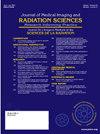放射学研究的全球趋势:三个关键期刊的文献计量学研究
IF 1.3
Q3 RADIOLOGY, NUCLEAR MEDICINE & MEDICAL IMAGING
Journal of Medical Imaging and Radiation Sciences
Pub Date : 2025-05-13
DOI:10.1016/j.jmir.2025.101960
引用次数: 0
摘要
以往对放射学期刊的文献计量学研究范围有限,只涵盖了1997-2011年、2013-2022年或2004-2011年等选择性时间段,分析的数据集相对较小,从706篇到1830篇不等,有一些局限性。本研究审查了自纳入Scopus数据库以来发表在《放射学》、《医学成像和辐射科学杂志》和《医学辐射科学杂志》上的3 875篇论文。使用R Studio中的Bibliometrix软件包计算定量文献计量指标,包括发表数、引用绩效和每篇文章/年的平均引用数。使用VOSviewer可视化共同作者和机构合作网络。通过关键词共现分析,确定优势研究领域并追踪其演变。调查结果显示,研究产出大幅增加,从1995年的15篇出版物增加到2024年的456篇。引文影响在2017年达到顶峰,随后几年逐渐下降。最多产的作者包括Hogg P.、Bolderston A.和Reed W.,而索尔福德大学、多伦多大学和悉尼大学则成为这三种期刊的领先机构。英国、加拿大和澳大利亚是主要的捐助国,非洲和亚洲国家的参与人数显著增加。资金主要由国家卫生机构、关注癌症的组织和学术机构提供。关键词分析揭示了9个主要主题集群,包括诊断成像技术、肿瘤学、临床实践、教育、以患者为中心的护理和公共卫生。重要的是,确定了8篇高被引论文(引用次数≥100次),其中许多论文对放射摄影的专业化做出了重大贡献,扩大了放射技师在诊断报告中的作用,并集成了人工智能和数字成像等新兴技术,标志着该领域发展的关键里程碑。总之,本研究呈现了放射学研究的大规模、期刊包容性文献计量学概况。它提供了关于全球贡献和合作模式的新见解,从而为制定未来的研究战略奠定了宝贵的基础。本文章由计算机程序翻译,如有差异,请以英文原文为准。
Global trends in radiography research: A bibliometric study of three key journals
Previous bibliometric studies of radiography journals have been limited in scope, covering selective time periods such as 1997–2011, 2013–2022, or 2004–2011, and analyzing relatively small datasets ranging from 706 to 1,830 articles with a few limitations. The present study examined 3,875 papers published in Radiography, Journal of Medical Imaging and Radiation Sciences, and Journal of Medical Radiation Sciences since their inclusion in the Scopus database.
Quantitative bibliometric indicators, including publication counts, citation performance, and mean citations per article/year, were computed using the Bibliometrix package in R Studio. Co-authorship and institutional collaboration networks were visualized using VOSviewer. Keyword co-occurrence analysis was also conducted to identify dominant research areas and trace their evolution over time.
Findings revealed a substantial rise in research output, increasing from 15 publications in 1995 to 456 in 2024. Citation impact peaked in 2017, with a gradual decline in subsequent years. The most prolific authors included Hogg P., Bolderston A., and Reed W., while the University of Salford, University of Toronto, and University of Sydney emerged as the leading institutions across the three journals. The United Kingdom, Canada, and Australia were dominant contributors, with a notable rise in participation from African and Asian countries. Funding was primarily supported by national health agencies, cancer-focused organizations, and academic institutions.
Keyword analysis revealed nine major thematic clusters, including diagnostic imaging technologies, oncology, clinical practice, education, patient-centered care, and public health. Importantly, eight highly cited papers (≥100 citations) were identified, many of which contributed significantly to the professionalization of radiography, expanded the role of radiographers in diagnostic reporting, and integrated emerging technologies such as AI and digital imaging—marking key milestones in the field’s development.
In summary, this study presents the large-scale, journal-inclusive bibliometric profile of radiography research. It offers new insights into global contributions, and collaboration patterns, thus serving as a valuable foundation for shaping future research strategies.
求助全文
通过发布文献求助,成功后即可免费获取论文全文。
去求助
来源期刊

Journal of Medical Imaging and Radiation Sciences
RADIOLOGY, NUCLEAR MEDICINE & MEDICAL IMAGING-
CiteScore
2.30
自引率
11.10%
发文量
231
审稿时长
53 days
期刊介绍:
Journal of Medical Imaging and Radiation Sciences is the official peer-reviewed journal of the Canadian Association of Medical Radiation Technologists. This journal is published four times a year and is circulated to approximately 11,000 medical radiation technologists, libraries and radiology departments throughout Canada, the United States and overseas. The Journal publishes articles on recent research, new technology and techniques, professional practices, technologists viewpoints as well as relevant book reviews.
 求助内容:
求助内容: 应助结果提醒方式:
应助结果提醒方式:


